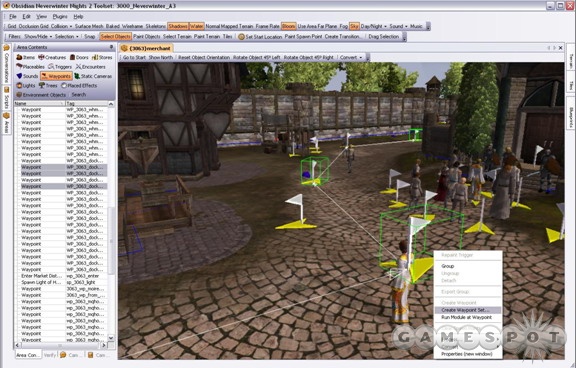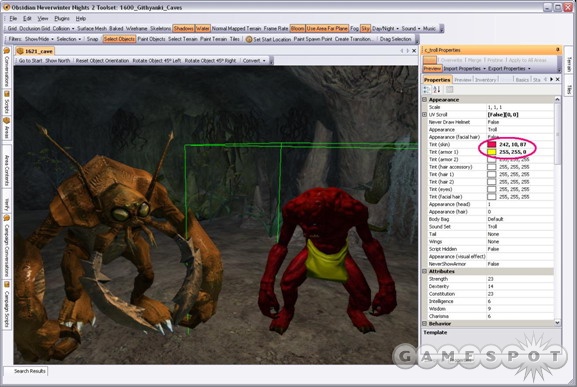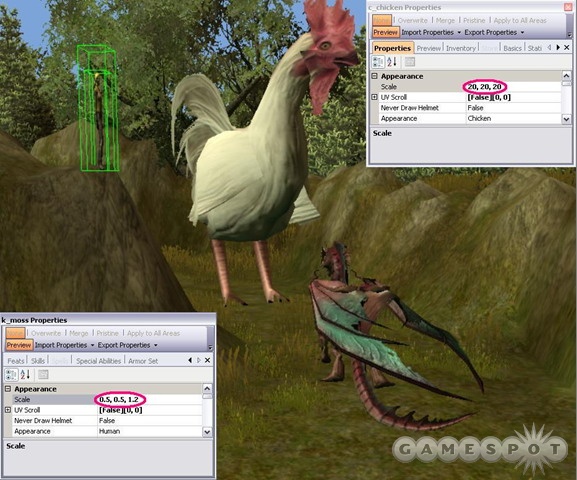Neverwinter Nights 2 Designer Diary #5 - Build Your Own Role-Playing Adventures
Senior designer Tony Evans tells us how easy it will be to create your own custom adventures in Neverwinter Nights 2.
Neverwinter Nights 2, the sequel to 2002's acclaimed fantasy role-playing game, went gold this week, which means that development is finished and the game is currently in production and on the way to shelves later this month. The series is set in the popular Fantasy Realms campaign setting of Dungeons & Dragons, and you will once again be able to create a D&D character to explore the city of Neverwinter and its environs, battle all manners of creatures, and be the kind of character you want to be, whether that's a thief or a mighty warrior.
Yet another cool aspect of Neverwinter Nights 2 is that the game comes with a powerful toolset that will let you create your own custom adventures, called modules. If the experience with the original Neverwinter Nights is any indication, expect hundreds of user-made adventures and campaigns to be shared online, and that translates into hundreds of hours of gameplay. Or, you can create your own modules and share them with others. This new toolset is a big step up from the Neverwinter Nights toolset in terms of power and flexibility, and we have senior designer Tony Evans of Obsidian Entertainment to explain some of its cool new features. The game should arrive in stores around the end of the month.

The Neverwinter Nights 2 Toolset
By Tony EvansSenior Designer, Obsidian Entertainment
There are far too many great things about Obsidian's Neverwinter Nights 2 toolset to list in a mere developer diary, so I'll restrain myself and list only what I think are the toolset's most exciting features.
10. Waypoint Paths - The toolset has many options to allow you to create living, breathing environments with ambient life that goes about its business. Using waypoint sets is one of the simplest ways of adding ambient life to an area, and it requires no scripting. Using waypoint sets, you can diabolically make peasants walk continuous circles.
9. Tinting - The toolset comes with many, many placeable objects, creatures, exterior terrain textures, and interior tilesets. But if you want even more variety, you can use tinting to create different-colored variations of almost everything. You can tint creatures, placeables, exterior terrain, and even tilesets to create dramatically different looks for your areas. Not happy with the look of your umber hulk? Tint him orange and turn him into an amber hulk.
8. Scaling - In case tinting isn't enough, the toolset allows you to change the scale of any creature or placeable. So if your adventure calls for a 40-foot-tall chicken or a dragon the size of a dog, you can make it so in the toolset. You can individually adjust the height, width, and length (x, y, and z). So if you want a female elf that is tall and superskinny, simply decrease the width and raise the height, and presto, your very own fantasy version of Kate Moss.

7. Run Module at Waypoint - Testing changes to your modules is easy. The standard way of doing this is to use the run module, which will load the module and put you at the start location. However, if you want to test a specific area, or a specific room in an area, you need only right click on a waypoint and choose "run module at waypoint." You can also choose to enter the area in free camera mode, which enables you to fly through your area.
6. Armor Sets - The toolset provides dozens of different creatures and races, each with multiple variations of faces, genders, and hair. In addition to this, clothing and armor is extremely customizable. You can choose from several different types and variations of armor, helms, boots, gloves, belts, and cloaks. Beyond that, you can add 22 different armor attachments, each with multiple variations. And, as with many other things, you can tint them all as you see fit. This allows you to create very unique appearances for your non-player characters. Best of all, you can save any armor sets as an item and give them to other characters to wear.
5. Static Cameras - Using static cameras in conjunction with Neverwinter Nights 2-style cutscenes creates impressive cinematics, such as the ones featured in the Neverwinter Nights 2 campaign. Adding a static camera is easy. Drop down the camera object and adjust its location and facing so that it points at what you want to show. You can use the preview window to see what your shot will look like in the game. Once your camera is placed, you can plug it into any dialogue node in a conversation.
4. Visual Effects Editor - Neverwinter Nights 2 comes with hundreds of different stunning visual effects, which you will see in action when you play the campaign. Even cooler, you can use the visual effects editor to make your own effects or make variations of existing effects.

3. Terrain Editor - The toolset allows you to quickly and easily create realistic-looking terrain. You can raise and lower terrain and paint the ground with a texture or a color. Then, complement your terrain by painting down grass or placing dozens of different kinds of trees. And last, but certainly not least, add water!
2. Conversation Editor - There are enough cool things in the conversation editor that it could easily fill a developer diary of its own, so I will briefly describe a few or the more revolutionary things:
You can specify parameters on action and condition scripts. This means that many users can avoid having to write custom scripts of their own and can instead take advantage of the hundreds of multipurpose global scripts provided by Obsidian.
Instead of laboriously copying and pasting individual links in a conversation, you can use the "link to main question node" feature, which creates a set of several links that can be copied. The link will automatically update if you add or delete nodes in your conversation.
And if you need your NPCs to cycle through random lines of dialogue, you can use "make bark cycle" and it will automatically fill in the scripts for you.
1. Customizable Layout - If you don't like the way the toolset is laid out by default, you can change it however you like. Almost all of the windows in the toolset are mode-less, which means that you can, for example, have an area (or two or three), conversations, and scripts all open at the same time. Customizing your toolset is as simple as drag and drop. If you prefer a more streamlined appearance, you can easily hide window tabs and bring them back again with a single click.
Got a news tip or want to contact us directly? Email news@gamespot.com
Join the conversation